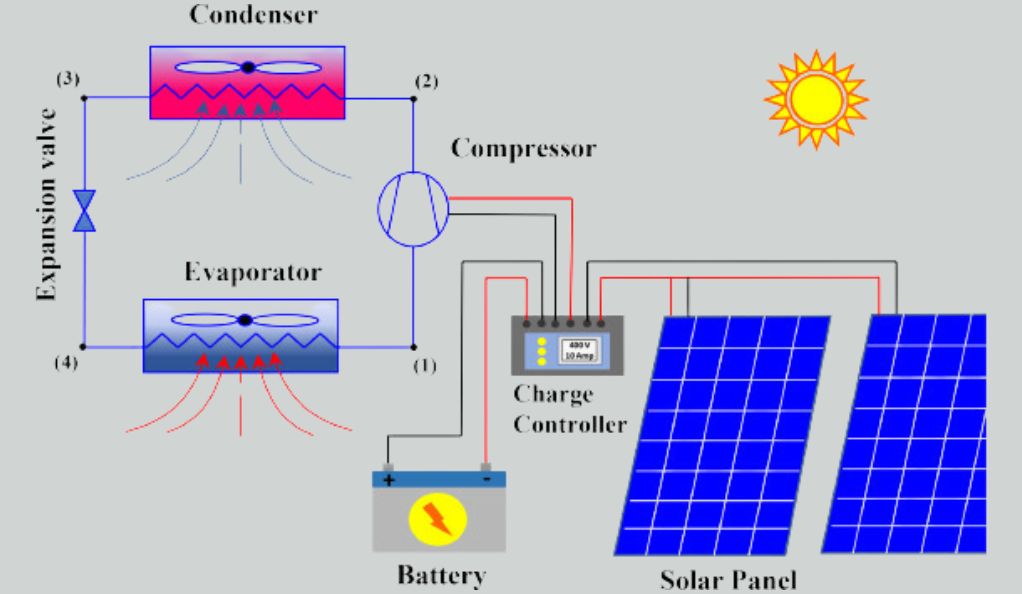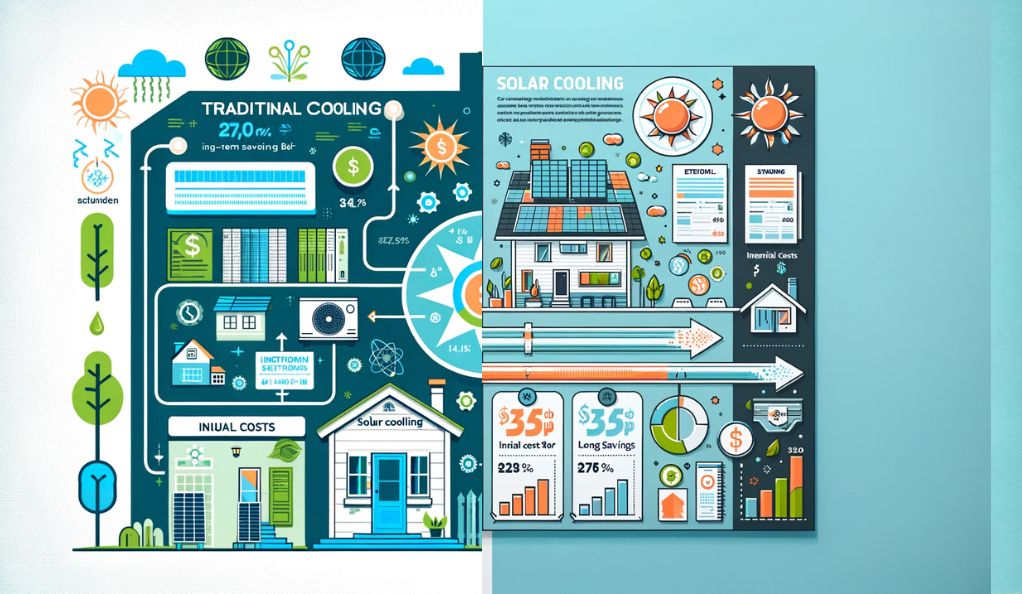Introduction to Solar Energy for Home Cooling
As we grapple with the challenges of energy conservation and environmental protection, solar energy emerges as a beacon of sustainable solutions. Particularly in the realm of home cooling, solar power presents itself not just as an alternative, but as a forward-thinking choice. This section delves into the essence of solar energy and the significant benefits it offers when used for home cooling, such as air conditioning and fans.
The Science Behind Solar Energy
Solar energy, at its core, is energy harnessed from the sun. This energy is both abundant and renewable, making it an ideal source for various applications, including home cooling. Solar panels, or photovoltaic (PV) cells, are the primary tools for capturing solar energy. They convert sunlight directly into electricity, which can then be used to power air conditioners and fans.
Why Solar Energy for Cooling?
The rationale behind using solar energy for home cooling is twofold: environmental and economic. From an environmental standpoint, solar energy is clean, producing no harmful emissions or pollutants. It significantly reduces the carbon footprint of a household, contributing to a healthier planet.
Economically, while the initial setup cost for solar energy systems can be substantial, the long-term savings are equally significant. Solar energy reduces reliance on the grid, thereby lowering electricity bills. Additionally, many regions offer incentives, rebates, or tax breaks for solar energy installation, further offsetting the initial costs.
Advantages Over Conventional Cooling Methods
Solar-powered cooling systems boast several advantages over traditional cooling methods:
- Renewability: Solar energy is limitless, unlike fossil fuels.
- Low Operating Costs: Once installed, the operational costs are minimal as sunlight is free.
- Reduced Carbon Footprint: Solar cooling significantly lowers greenhouse gas emissions.
- Independence from Grid Fluctuations: Solar cooling provides a degree of independence from grid-related issues, including price hikes and power outages.
Solar Energy and Home Cooling: A Perfect Match
Pairing solar energy with home cooling systems is a match made in heaven for the environmentally conscious homeowner. Whether it’s through solar air conditioners or solar-powered fans, the integration promises efficiency and sustainability.
Understanding Solar Air Conditioning Systems

In the quest for sustainable home cooling solutions, solar air conditioning systems stand out for their efficiency and eco-friendliness. This section explores how these systems operate, the different types available, and how they compare with traditional air conditioning units.
How Solar Air Conditioners Work
Solar air conditioning operates on the principle of converting sunlight into electricity, which then powers the cooling system. There are primarily two types of solar air conditioning systems:
- Photovoltaic (PV) Systems: These systems use solar panels to convert sunlight directly into electricity, which powers a conventional air conditioner compressor.
- Solar Thermal Systems: These systems harness sunlight to generate heat, which is then used to drive a cooling process, often through absorption or adsorption refrigeration cycles.
Comparison with Traditional AC Units
When comparing solar air conditioners to traditional units, several factors stand out:
- Energy Source: Solar ACs use renewable energy, while traditional ACs rely on electricity from the grid, often generated from non-renewable sources.
- Operating Costs: Solar ACs can offer lower long-term costs due to reduced electricity usage.
- Environmental Impact: Solar ACs have a lower carbon footprint, aligning with environmental sustainability goals.
- Initial Investment: The upfront cost for solar ACs is typically higher, but this is often offset by long-term savings and potential incentives.
Benefits and Limitations
Solar air conditioning systems offer a sustainable alternative to traditional air conditioning. They are particularly beneficial in regions with abundant sunlight. However, their efficiency can be affected by weather conditions, and the initial investment is significant. Despite these limitations, solar ACs represent a step forward in the use of renewable energy for home cooling.
A Step Towards Sustainable Living
Understanding the mechanics and benefits of solar air conditioning systems is essential for homeowners considering a shift towards more sustainable living practices. In the following sections, we will explore solar-powered fans, delve into the cost analysis of solar cooling, and discuss installation and maintenance aspects, providing a comprehensive guide to adopting solar energy for home cooling.
Solar-Powered Fans: An Eco-Friendly Alternative
In the pursuit of eco-friendly cooling solutions, solar-powered fans present a compelling case. These devices offer an energy-efficient way to cool homes, relying solely on solar energy. This section delves into the types of solar fans available, their advantages over conventional fans, and how they can be integrated into existing home cooling systems.
Types of Solar-Powered Fans
Solar-powered fans come in various designs, each tailored to specific needs and settings. The most common types include:
- Solar Attic Fans: Designed to ventilate the attic, reducing heat build-up and lowering overall cooling costs.
- Solar Ceiling Fans: Operate like traditional ceiling fans but are powered by solar panels.
- Portable Solar Fans: Ideal for personal use, these can be easily moved and are perfect for outdoor activities.
Integrating Solar Fans with Home Cooling Systems
Solar-powered fans can be a valuable addition to traditional cooling systems. They can be used in tandem with air conditioners to increase efficiency. For example, solar attic fans reduce the overall temperature of the house, easing the load on air conditioners. This integration not only enhances cooling efficiency but also contributes to significant energy savings.
Cost-Efficiency and Sustainability
While the initial investment in solar fans might be higher than conventional fans, the long-term savings in electricity bills make them a cost-effective choice. Moreover, their reliance on solar energy aligns with sustainable living practices, making them a responsible choice for environmentally conscious homeowners.
Cost Analysis: Solar Cooling vs. Traditional Methods

Adopting solar cooling involves considering its cost-effectiveness compared to traditional methods. This section offers a concise analysis of the financial aspects, focusing on initial costs, long-term savings, and payback periods.
Initial Investment Comparison
Solar cooling systems, including solar air conditioning and fans, generally have a higher initial cost compared to traditional AC and fans. Factors influencing this include the size and type of the solar technology.
Long-Term Savings
Despite the higher upfront cost, solar cooling systems can lead to significant long-term savings through reduced or eliminated electricity bills. Additionally, many regions offer incentives for installing solar systems, further enhancing their cost-effectiveness.
Payback Period
The payback period for solar systems varies but typically ranges from 5 to 10 years. It depends on local energy costs, the amount of sunlight, and available incentives. After this period, the savings gained can effectively offset the initial investment.
Beyond Costs: Environmental Impact
Apart from financial savings, solar cooling contributes to a reduced carbon footprint and supports renewable energy use, offering both economic and environmental benefits.
Installation and Maintenance of Solar Cooling Systems
The successful adoption of solar cooling technologies hinges on proper installation and regular maintenance. This section provides insights into the installation process and maintenance tips for solar air conditioning and fan systems, ensuring their optimal performance and longevity.
Installation of Solar Cooling Systems
- Choosing the Right System: The first step is selecting the appropriate solar cooling system based on your home’s size, location, and cooling needs.
- Site Assessment: A professional assessment is vital to determine the optimal placement of solar panels for maximum sunlight exposure.
- Professional Installation: It’s recommended to have solar cooling systems installed by certified professionals to ensure safety and efficiency.
- Grid Connection and Permissions: Depending on your location, connecting your system to the grid and obtaining necessary permissions might be required.
Troubleshooting Common Issues
- Reduced Efficiency: Often due to dirty solar panels or filters. Regular cleaning can prevent this.
- System Not Working: Check for any disconnected wires or tripped circuit breakers. If the issue persists, consult a professional.
- Battery Issues (for battery-backed systems): Ensure batteries are properly maintained and replace them when necessary.
Long-Term System Care
Consistent maintenance ensures the longevity and efficiency of solar cooling systems. It’s advisable to have an annual check-up by a professional, especially for the solar components.
Conclusion
In summarizing our exploration of solar energy for home cooling, it’s evident that this innovative approach is not just an eco-friendly alternative, but a significant step towards sustainable living. Solar-powered air conditioning and fans offer an effective solution to reduce energy consumption and utility costs. These systems, while presenting a higher initial investment, offer long-term economic benefits through reduced energy bills and potential government incentives. Proper installation and maintenance ensure their efficiency and longevity. As we move towards a greener future, homeowners are encouraged to consider the impactful benefits of solar cooling. Adopting this technology is a powerful statement in support of a cleaner, more sustainable environment, marking a positive step for both the present and future generations.
